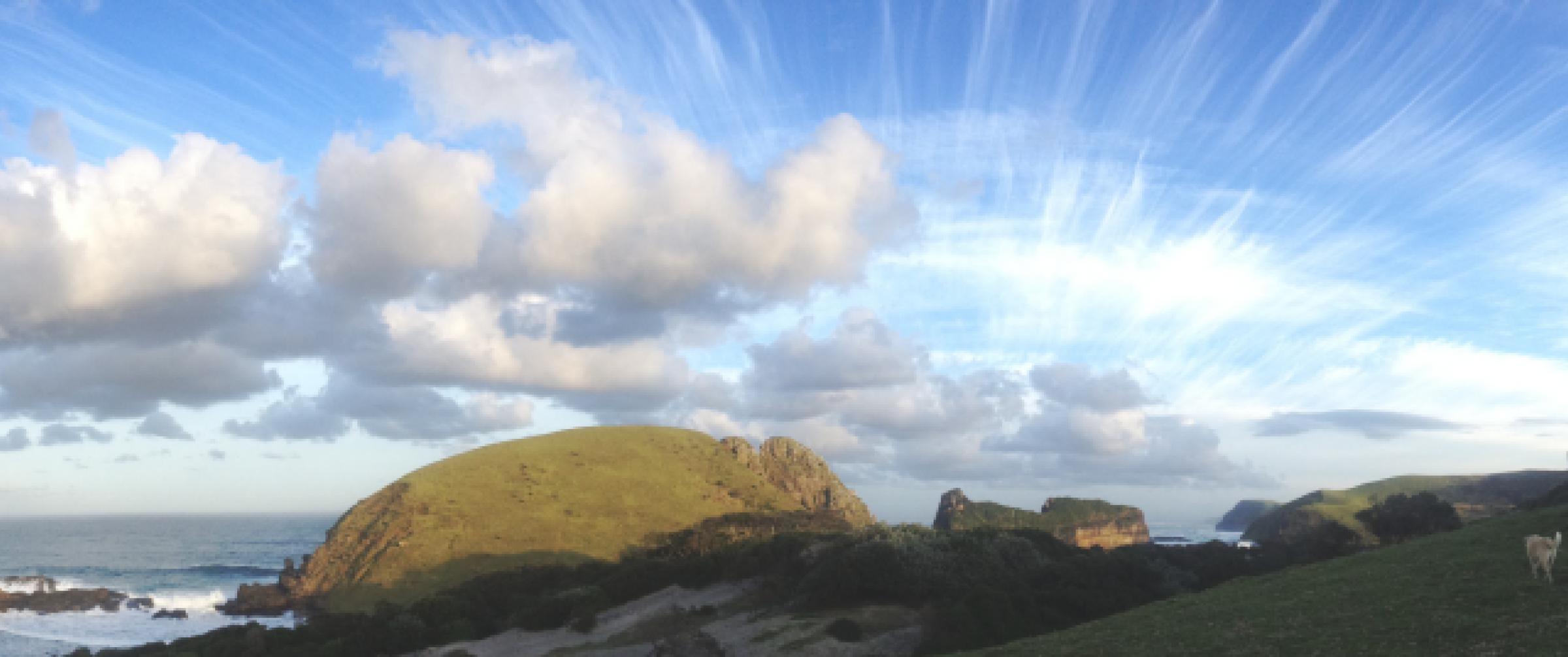Take a walk on the Wild side . . .
History and folklore of Hole in the Wall
Hole-in-the-Wall is one of the most impressive landmarks along the entire South African coastline. Second only to Table Mountain, though only a fraction of the size.
Standing at the mouth of the Mpako River, the cliff consists of dark-blue shales, mudstones and sandstones of the Ecca Group, dating back some 260 million years. These rocks were subsequently intruded by a dolerite sheet, and the ‘hole’ was created over millions of years by the buffeting waves, which eroded away the softer rocks underneath the dolerite to form an arch. The same process also eventually separated the cliff from the mainland.
Hole-in-the-Wall was named by Captain Vidal of the vessel Barracouta, sent by the British Admiralty in 1823 to survey the coastline between the Keiskamma River and Lourenço Marques (now Maputo). Vidal took his ship to within 800m of the coast, and described in his log "where two ponderous black rocks above the water’s edge, upwards of 80 feet above its surface, exhibiting through the phenomenon of a natural archway", prompting him to name it the Hole-in-the-Wall.
The local Bomvana people named the formation ‘EsiKhaleni’, or the Place of the Sound.
Local legend has it that the river running through the Hole-in-the-Wall (Mpako River) once formed a landlocked lagoon as its access to the sea was blocked by a cliff.
A beautiful girl lived in a village near the lagoon cut off from the sea by the mighty cliff. One day she was seen by one of the sea people - semi deities who look like humans but have supple wrists and ankles and flipperlike hands and feet - who became overwhelmed by her beauty and tried to woo her.
When the girl’s father found out he forbade her to see her lover. So at high tide one night, the sea people came to the cliff and, with the help of a huge fish, rammed a hole through the centre of the cliff. As they swam into the lagoon they shouted and sang, causing the villagers to hide in fear. In the commotion the girl and her lover were reunited and disappeared into the sea.
At certain times of the year, it is said, the music and singing of the sea people can be heard.
Xhosa legend holds that this is the gateway to the world of their ancestors.
The local Xhosa call this place "esiKhaleni", which means "place of sound".
During certain seasons and water conditions the waves clap in such a fashion that the concussion can be heard throughout the valley.
Hole-in-the-Wall and the tragedy of the prophetess:
A young girl called Nongqawuse had seen a messenger from the realm of the ancestors at a waterhole. She told her uncle Mhlakaza about her vision. As he was an important Xhosa priest, his social rank granted a great impact to the prophecy he derived from his niece's vision.
He announced that soldiers who were incarnations of the souls of dead Xhosa warriors, would arrive on the 18th of February over the sea, come onto land through the "Hole in the Wall" and defeat the hated British. But, he continued, the Xhosa had to make a sacrifice to help the warriors by destroying all their cereals and killing all their cattle. After the victory, there would be food in abundance for everybody.
The Xhosa followed the instructions in his prophecy and killed their whole stock of cattle. The catastrophe took its course and thousands of Xhosa perished from famine. (See: http://www.wildcoast.com/nongqawuse for the western version of the story, with fascinating comments about a conspiracy surrounding the possible genocide.)
Horizontal Tabs Group
Total views: 48,985 |


Comments
Riaan (not verified)
Thu, 31/03/2011 - 09:54
Permalink
Nongqawuse and Hole in the Wall
Didn't the events surrounding Nongqawuse all unfold on the Gxara river rear Qolora, not at Hole in the Wall?
Jeff Brown
Thu, 31/03/2011 - 10:42
Permalink
Nongqawuse & Hole in the Wall
The Bomvana people North of the Mbashe River were not affected by the cattle killings, except to take pity on some of the displaced and impoverished Gcaleka tribes-people seeking refuge.
The connection between Nongqawuse & Hole in the Wall is the mythology that the warrior 'amathongo' would return through the Hole in the Wall.
Delene (not verified)
Sun, 03/04/2011 - 09:57
Permalink
Nongqwuse & Hole in The wall
The place where the vision was seen, was below the waterfall on the Gxara river, near Qolora Mouth {trenneries/ Seagulls} The girl lived in the huts up on the hill above there falls.
Add new comment